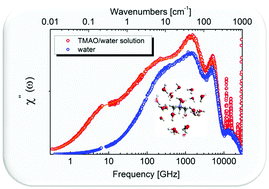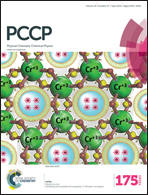Aqueous solvation of amphiphilic molecules by extended depolarized light scattering: the case of trimethylamine-N-oxide†
Abstract
Hydrophilic and hydrophobic interactions strongly affect the solvation dynamics of biomolecules. To understand their role, small model systems are generally employed to simplify the investigations. In this study the amphiphile trimethylamine N-oxide (TMAO) is chosen as an exemplar, and studied by means of extended frequency range depolarized light scattering (EDLS) experiments as a function of solute concentration. This technique proves to be a suitable tool for investigating different aspects of aqueous solvation, being able at the same time to provide information about relaxation processes and vibrational modes of solvent and solute. In the case study of TMAO, we find that the relaxation dynamics of hydration water is moderately retarded compared to the bulk, and the perturbation induced by the solute on surrounding water is confined to the first hydration shell. The results highlight the hydrophobic character of TMAO in its interaction with water. The number of molecules taking part in the solvation process decreases as the solute concentration increases, following a trend consistent with the hydration water-sharing model, and suggesting that aggregation between solute molecules is negligible. Finally, the analysis of the resonant modes in the THz region and the comparison with the corresponding results obtained for the isosteric molecule tert-butyl alcohol (TBA) allow us to provide new insights into the different solvating properties of these two biologically relevant molecules.


 Please wait while we load your content...
Please wait while we load your content...